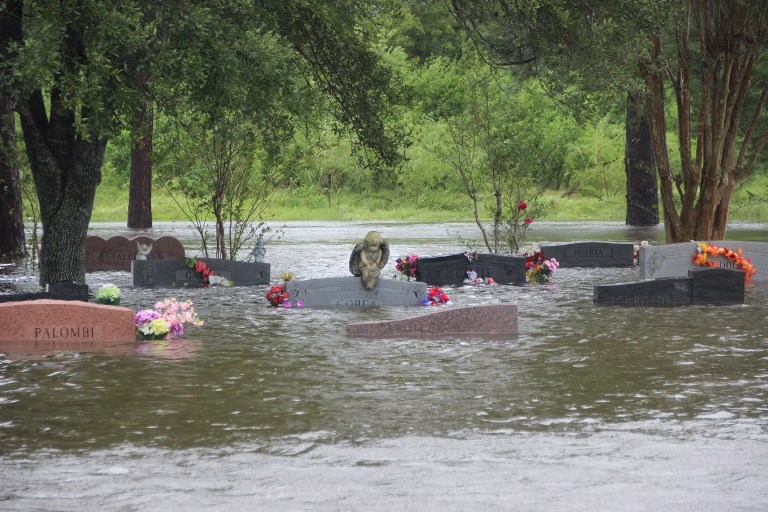Harvey damage estimated at $42B, among most costly US storms

The South Park Cemetery in Pearland, Texas, is flooded by rains from Hurricane Harvey on August 29, 2017.
Damage from Hurricane Harvey could put it among the top five most costly US storms ever, with failing dams and levees driving up loss forecasts, data modeling showed Tuesday./ AFP PHOTO / AFP/LamaLens / H. Ellessy
Washington, United States — Damage from Hurricane Harvey could put it among the top five most costly US storms ever, with failing dams and levees driving up loss forecasts, data modeling showed Tuesday.
Estimates for total economic costs and damage shot up overnight to $42 billion from $30 billion, as flooding began to spread to Louisiana and flood control measures became overwhelmed, according to Chuck Watson, founder of the disaster modeling firm Enki Research.
While authorities still focused on rescuing survivors on Tuesday, the question of the storm’s aftermath — and its expected long-lasting hit to the Texas and US economies — was only beginning to come into view.
Recent research also shows natural disasters can result in more concentrated poverty in former disaster areas.
“If Harvey were your normal hurricane it would be probably a $4 billion event,” Watson told AFP. “That would be tragic for the people affected, but for the effect on the macroeconomy, we wouldn’t be talking about it at all.”
Article continues after this advertisementAs yet, the storm is nowhere near as costly as 2005’s Hurricane Katrina, which took a $118 billion bite out of the regional economy.
Article continues after this advertisementBut at $42 billion in unrecoverable economic losses, Harvey would be about as damaging as Hurricane Ike, which struck Texas and parts of the Caribbean at a cost of $43 billion in 2008, and Hurricane Wilma, which tore through North America in 2005, with a cost of nearly $38 billion, according to Watson’s estimates.
And the Harvey estimate could still go up.
Fleeing the wreckage, deepening poverty
A US energy hub with $1.6 trillion in annual economic output, Texas accounts for nearly nine percent of America’s GDP, the second largest state economy after California — and larger than Canada or South Korea.
Goldman Sachs estimated Monday that Harvey’s disruptions to the energy sector alone could shave as much as 0.2 percentage points off of US GDP growth in the third quarter of this year.
Leah Boustan, professor of economics at Princeton University, said that over time natural disasters tend to cause wealthier residents to flee the devastation, leaving poorer inhabitants to face the economic fallout.
Boustan co-authored a recent study which examined data from 5,000 US floods, earthquakes and storms spanning the 20th century.
“Translating our results into the context of Houston would suggest that 23,000 residents would move away from the area over the next 10 years,” she told AFP.
“We also found that very severe disasters tend to increase the poverty rate in an area by around one percentage point, which for Houston would be an increase from 25 percent to 26 percent of the population living below the poverty line,” she added.
The Texas Gulf coast, home to nearly a third of the US oil refining capacity, has been ravaged by the most powerful hurricane to hit the state since 1961, which shuttered least 15 percent of US refining capacity, according to The Wall Street Journal.
In addition to oil and gas producers, Texas is home to defense contractors, computer components makers, manufacturing and a sprawling agricultural sector.
Natural disasters like floods and hurricanes can force entire towns into unemployment, interrupt tax collection and disrupt supplies of food and fuel for months, jacking up costs and reducing demand elsewhere.
Facing reconstruction uninsured
According to the Insurance Information Institute, only 12 percent of homeowners in designated flood areas in the United States were covered by flood insurance in 2016.
Loretta Worters, a spokesperson for the institute, told AFP the uninsured could be looking at ruin without government assistance.
”It could be total loss for them,” she said.
But Watson of Enki Research said the federal maps that designate flood-prone areas — where homeowners usually are required to obtain flood insurance — are inaccurate and obsolete, meaning the share of people insured against damage from Harvey will be minimal.
“Our initial estimate is that two-thirds of the flooding happened outside flood zones,” he said.
Recovery will be especially difficult for the poorest wage earners, whose income stops the moment they are unable to work.
“They’re not getting paid. They’ve got bills stacked up. Their homes are damaged,” he said. “That’s where the real humanitarian disaster is going to happen.”